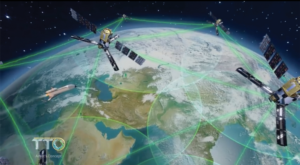Iron integral to the development of life on Earth - and the possibility of life on other planets
Sunday, 12 December 2021 11:06 Iron is an essential nutrient that almost all life requires to grow and thrive. Iron's importance goes all the way back to the formation of the planet Earth, where the amount of iron in the Earth's rocky mantle was 'set' by the conditions under which the planet formed and went on to have major ramifications for how life developed.
Now, scientists at the University of Oxford have uncovered
Iron is an essential nutrient that almost all life requires to grow and thrive. Iron's importance goes all the way back to the formation of the planet Earth, where the amount of iron in the Earth's rocky mantle was 'set' by the conditions under which the planet formed and went on to have major ramifications for how life developed.
Now, scientists at the University of Oxford have uncovered High-tech sleeping bag could solve vision issues in space
Sunday, 12 December 2021 11:06 A subtle smile emerged on Dr. James Leidner's face as he envisioned telling people of the unusual contribution he made to mankind's mission to Mars.
For 72 straight hours, the study volunteer lay in a bed at UT Southwestern, the monotony broken only at night when researchers placed his lower body in a sealed, vacuum-equipped sleeping bag to pull down body fluids that naturally flowed int
A subtle smile emerged on Dr. James Leidner's face as he envisioned telling people of the unusual contribution he made to mankind's mission to Mars.
For 72 straight hours, the study volunteer lay in a bed at UT Southwestern, the monotony broken only at night when researchers placed his lower body in a sealed, vacuum-equipped sleeping bag to pull down body fluids that naturally flowed int Airbus and DLR intensify cooperation
Sunday, 12 December 2021 11:06 Airbus and the German Aerospace Center are expanding their cooperation in research on climate protection in aviation. Under an agreement signed by Nicole Dreyer-Langlet, Airbus' VP Research and Technology Representative, Germany, and Markus Fischer, DLR Divisional Board Member Aeronautics, future joint projects will focus, in particular, on emission measurements for new types of aviation fuels,
Airbus and the German Aerospace Center are expanding their cooperation in research on climate protection in aviation. Under an agreement signed by Nicole Dreyer-Langlet, Airbus' VP Research and Technology Representative, Germany, and Markus Fischer, DLR Divisional Board Member Aeronautics, future joint projects will focus, in particular, on emission measurements for new types of aviation fuels, The uneven universe
Sunday, 12 December 2021 11:06 It is almost always assumed in cosmological calculations that there is a even distribution of matter in the universe. This is because the calculations would be much too complicated if the position of every single star were to be included. In reality, the universe is not uniform: in some places there are stars and planets, in others there is just a void.
Physicists Michael te Vrugt and Prof
It is almost always assumed in cosmological calculations that there is a even distribution of matter in the universe. This is because the calculations would be much too complicated if the position of every single star were to be included. In reality, the universe is not uniform: in some places there are stars and planets, in others there is just a void.
Physicists Michael te Vrugt and Prof Strahan flies to space with astronaut's daughter: 'Wow!'
Sunday, 12 December 2021 10:30
Football star and TV celebrity Michael Strahan caught a ride to space with Jeff Bezos' rocket-launching company Saturday, sharing the trip with the daughter of America's first astronaut.
"TOUCHDOWN has a new meaning now!!!" he tweeted after landing.
Blue Origin's New Shepard rocket blasted off from West Texas, sending the capsule on a 10-minute flight with the two VIP guests and four paying customers.
Bezos' Blue Origin completes third crewed space flight
Saturday, 11 December 2021 21:40
Jeff Bezos' Blue Origin company blasted its third private crew into space on Saturday and brought it back safely, this time including the daughter of the first American astronaut.
The stubby white spacecraft with a round tip blasted off into clear blue skies over West Texas for a roughly 11-minute trip to just beyond the internationally recognized boundary of space, 62 miles (100 kilometers) high.
The six-member crew hooted with glee as they unbuckled to enjoy a few minutes of weightlessness, looking out at space through tall windows in the capsule.
"I've never seen anything like that," one unidentified crew member said as Blue Origin livestreamed the flight.
Parsons to develop prototype ground operations center for DARPA’s Blackjack satellites
Saturday, 11 December 2021 19:26
The Defense Advanced Research Projects Agency awarded Parsons a $10.8 million contract to prototype a ground operations center for the agency’s Blackjack constellation.
Parsons to develop ground operations center for DARPA’s Blackjack satellites
Saturday, 11 December 2021 19:26
The Defense Advanced Research Projects Agency awarded Parsons a $10.8 million contract to prototype a ground operations center for the agency’s Blackjack constellation.
Space vacuuming in 360° | Cosmic Kiss
Saturday, 11 December 2021 16:00 Video:
00:03:28
Video:
00:03:28
Even astronauts in orbit cannot escape housework. Join ESA astronaut Matthias Maurer as he vacuums the European Columbus and Japanese Kibo modules of the International Space Station in this 360° video.
Unlike on Earth, dust on the Space Station does not settle. Astronauts vacuum regularly to prevent floating dust from getting in their eyes and noses, causing irritation and allergic reactions. Pan to explore the different modules and follow Matthias’s work.
Matthias was launched to the International Space Station on Crew Dragon Endurance as part of Crew-3 at 02:03 GMT/03:03 CET Thursday 11 November. His ESA mission on board
Daughter of first American astronaut launches on Blue Origin flight
Saturday, 11 December 2021 15:23 Jeff Bezos' Blue Origin company blasted its third private crew to space on Saturday, this time including the daughter of the first American astronaut.
The stubby white spacecraft with a round tip blasted off into clear blue skies over West Texas for a roughly 11 minute trip to just beyond the internationally-recognized boundary of space, 62 miles (100 kilometers) high.
The six-member cre
Jeff Bezos' Blue Origin company blasted its third private crew to space on Saturday, this time including the daughter of the first American astronaut.
The stubby white spacecraft with a round tip blasted off into clear blue skies over West Texas for a roughly 11 minute trip to just beyond the internationally-recognized boundary of space, 62 miles (100 kilometers) high.
The six-member cre Blue Origin launches first six-person New Shepard suborbital flight
Saturday, 11 December 2021 14:35
Blue Origin launched its third crewed New Shepard suborbital mission Dec. 11, carrying six people on a brief flight to the edge of space.
Chinese Yutu-2 rover embarks on weeks-long 80-metre journey to reach Moon Cube
Saturday, 11 December 2021 10:52 As China's Yutu-2 lunar rover set off to investigate a peculiar shape dubbed the "moon cube," which the craft spotted earlier this month, the rover will take its time travelling to it.
According to VICE, however, there's a good reason why it may take about two to three lunar days, "or two to three months on Earth," for the rover to reach the object supposedly located about 80 metres away.
As China's Yutu-2 lunar rover set off to investigate a peculiar shape dubbed the "moon cube," which the craft spotted earlier this month, the rover will take its time travelling to it.
According to VICE, however, there's a good reason why it may take about two to three lunar days, "or two to three months on Earth," for the rover to reach the object supposedly located about 80 metres away. China's Long March carrier rocket embarks on 400th mission
Saturday, 11 December 2021 10:52 A Long March-4B rocket on Friday morning successfully sent a new group of satellites into space, marking the 400th launch mission of the China-developed Long March carrier rocket series.
Since the first launch in 1970, the Long March carrier rocket series has carried out 92.1 percent of China's space launch mission, according to the China Aerospace Science and Technology Corporation (CASC)
A Long March-4B rocket on Friday morning successfully sent a new group of satellites into space, marking the 400th launch mission of the China-developed Long March carrier rocket series.
Since the first launch in 1970, the Long March carrier rocket series has carried out 92.1 percent of China's space launch mission, according to the China Aerospace Science and Technology Corporation (CASC) Father's foundry job inspires Dr. Sharon Cobb to pursue NASA career path
Saturday, 11 December 2021 10:52 Career inspiration can come from many places. For Space Launch System (SLS) Program Associate Manager Dr. Sharon Cobb, it was her father's work at a foundry in Birmingham, Alabama.
During a family employee event, Cobb saw molten steel being poured into molds to form large ingots, large metal blocks that would later be made into usable structures, and she was hooked.
"I was just fasci
Career inspiration can come from many places. For Space Launch System (SLS) Program Associate Manager Dr. Sharon Cobb, it was her father's work at a foundry in Birmingham, Alabama.
During a family employee event, Cobb saw molten steel being poured into molds to form large ingots, large metal blocks that would later be made into usable structures, and she was hooked.
"I was just fasci Blue Origin plans to launch largest crew yet Saturday
Saturday, 11 December 2021 10:52 Jeff Bezos' Blue Origin rocket company plans to launch six people, its largest crew yet, including the daughter of late astronaut Alan Shepard and ABC News anchor Michael Strahan, into space Saturday from Texas.
Blue Origin plans liftoff of the New Shepard rocket on its NS-19 mission at 8:45 a.m. CST from its Corn Ranch spaceport 160 miles east of El Paso. Launch personnel postponed a laun
Jeff Bezos' Blue Origin rocket company plans to launch six people, its largest crew yet, including the daughter of late astronaut Alan Shepard and ABC News anchor Michael Strahan, into space Saturday from Texas.
Blue Origin plans liftoff of the New Shepard rocket on its NS-19 mission at 8:45 a.m. CST from its Corn Ranch spaceport 160 miles east of El Paso. Launch personnel postponed a laun 